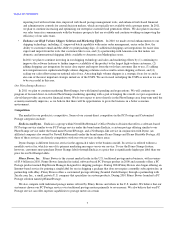Stamps.com 2010 Annual Report Download - page 20
Download and view the complete annual report
Please find page 20 of the 2010 Stamps.com annual report below. You can navigate through the pages in the report by either clicking on the pages listed below, or by using the keyword search tool below to find specific information within the annual report.
TABLE OF CONTENTS
The USPS could also decide that PC Postage should no longer be an approved postage service due to security concerns,
financial difficulties within the USPS or other issues. Our business would suffer dramatically if we are unable to adapt our
services to any new requirements or specifications or if the USPS were to discontinue PC Postage as an approved postage
method. Alternatively, the USPS could introduce competitive programs or amend PC Postage requirements to make certification
easier to obtain, which could lead to more competition from third parties or the USPS itself. If we are unable to compete
successfully, particularly against large, traditional providers of postage products, such as Pitney Bowes, who enter the online
postage market, our revenues and operating results will suffer.
The USPS could decide that PhotoStamps should no longer be an approved product for such reasons as the belief that
PhotoStamps presents an unacceptable risk to USPS revenues, exposes the USPS or its customers to legal liability, or causes
public or political embarrassment or harm to the USPS in any way. If the USPS were to discontinue PhotoStamps, our revenues
and operating results will suffer.
Additionally, the USPS could decide to amend, renegotiate or terminate agreements or financial compensation arrangements
that exist now or in the future. For instance, if the USPS decides to amend, renegotiate or terminate our credit card cost sharing
agreement, which is a key agreement that governs the allocation of credit card fees paid by the USPS and us, our revenues and
operating results will likely suffer.
In addition, USPS regulations may require that our personnel with access to postal information or resources receive security
clearance prior to doing relevant work. We may experience delays or disruptions if our personnel cannot receive necessary
security clearances in a timely manner, if at all. The regulations may limit our ability to hire qualified personnel. For example,
sensitive clearance may only be provided to US citizens or aliens who are specifically approved to work on USPS projects.
Finally, any approved USPS market test or new service that benefits us could also ultimately be suspended or cancelled by
the USPS, causing disruptions to our business.
If we are unable to compete successfully, particularly against large, traditional providers of postage products, such as
Pitney Bowes, our revenues and operating results will suffer.
The PC Postage segment of the market for postage is relatively new and is competitive. At present, Pitney Bowes and
Endicia.com (a wholly owned subsidiary of Newell Rubbermaid) are authorized PC Postage providers with commercially
available software. If any more providers become authorized, or if Pitney Bowes or Endicia.com provide enhanced offerings, our
operations could be adversely impacted. We also compete with other forms of postage, including traditional postage meters
provided by companies such as Pitney Bowes, postage stamps and permit mail.
We may not be able to establish or maintain a competitive position against current or future competitors as they enter the
market. Many of our competitors have longer operating histories, larger customer bases, greater brand recognition, greater
financial, marketing, service, support, technical, intellectual property and other resources than us. As a result, our competitors
may be able to devote greater resources to marketing and promotional campaigns, adopt more aggressive pricing policies and
devote substantially more resources to web site and systems development. This increased competition may result in reduced
operating margins, loss of market share and a diminished brand. We may from time to time make pricing, service or marketing
decisions or acquisitions as a strategic response to changes in the competitive environment. These actions could result in reduced
margins and seriously harm our business.
We could face competitive pressures from new technologies or the expansion of existing technologies approved for use by
the USPS. We may also face competition from a number of indirect competitors that specialize in electronic commerce and other
companies with substantial customer bases in the computer and other technical fields. Additionally, companies that control
access to transactions through a network or Web browsers could also promote our competitors or charge us a substantial fee for
inclusion. In addition, changes in postal regulations could adversely affect our service and significantly impact our competitive
position. We may be unable to compete successfully against current and future competitors, and the competitive pressures we
face could seriously harm our business.
16
























